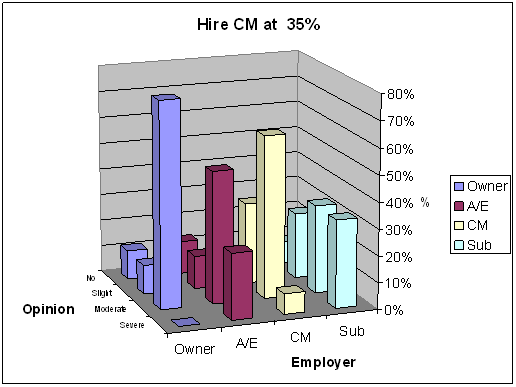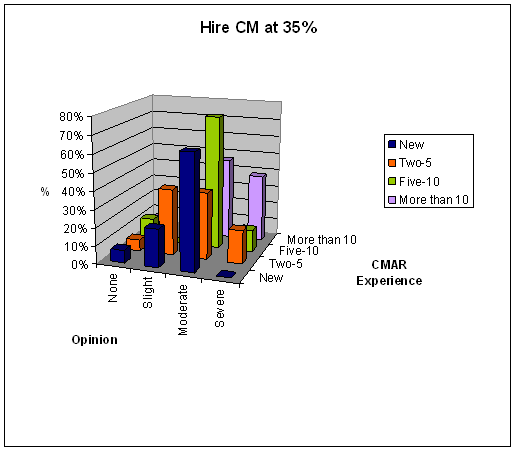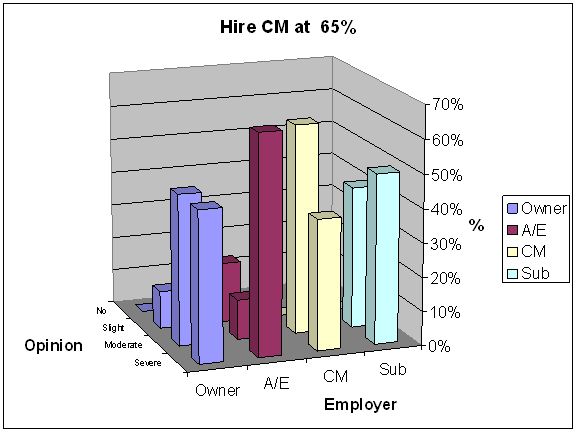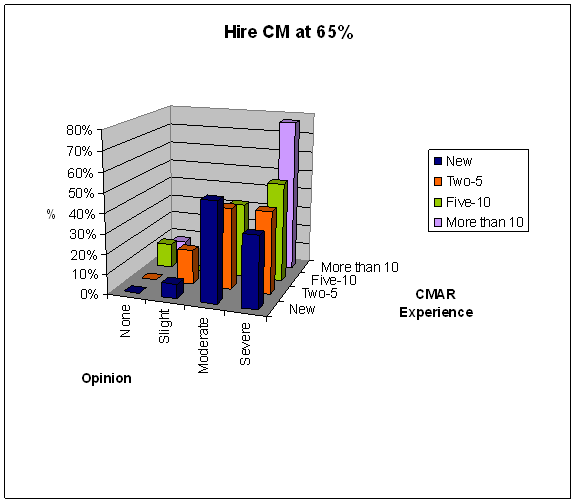
When to hire the CM
Parties’ attitudes differ on timing of hiring the CM; A/Es perceive severe impacts earlier than Owners and CMs.
Summary
While all the parties believe it is beneficial to start the CM as early as possible, there is a difference between the attitudes towards a later start. A/Es see severe impacts earlier than Owners or CMs. Subs are similar to A/Es in that regard. An explanation may be that Owners want to use CMAR as opposed to DBB, and CMs want the job, so both believe a late start is better than none. A/Es understand it is always possible to reduce costs by reducing scope, but this necessitates redesign and possible sub-optimization, which could be avoided with timely constructability and cost input. With a late start, Subs must make hard cost choices in a very constrained environment, while earlier they may have been able to influence the environment to deliver a more efficient product.
Report
Of course it is a no-brainer, the earlier the CM is hired, the better. There was some difference of opinion regarding the impact from late hiring, and from that difference we may glean some insight into the dynamics of the parties. We asked about the negative impact of not hiring the CM until the 10%/schematics, 35%/design development, 65%/design review, and 95%/construction documents phases. Almost all of the parties felt there was no negative impact from not hiring until the 10% and a severe negative impact from not hiring until the 95%. The parties’ reactions to hiring at the intermediate completion stage was interesting.
By employer:

By employer, more A/Es and Subs felt it had a severe impact not to hire until 35%, while fewer CMs and no Owners felt it was severe.

By CMAR experience, none of the respondents new to CMAR felt it was severe, while those with more experience did. Of those who had experience with more than 10 CMAR projects, almost 40% felt it was severe. If None and Slight are grouped and compared with Moderate and Severe, we see quite a difference between respondents newer to CMAR and respondents more experienced with CMAR.
CMAR Experience |
No or Slight Impact |
Moderate or Severe Impact |
New |
29% |
64% |
Two-5 |
44% |
56% |
Five-10 |
13% |
88% |
>10 |
15% |
85% |
A tentative conclusion is that respondents with more CMAR experience believe it is harmful for the project to start the CM at 35% design (the schematic design), when the main project concepts, but few details, have been decided. Why the Owners and CMs seem less concerned about this than the A/Es and Subs is interesting. We will discuss this more below.
Next we consider not hiring the CM until 65% design, the design development stage.

More Owners and CMs see a problem with not hiring the CM until 65% design, and more A/Es see the problem as severe. Regardless of experience, most parties see it as moderate or severe to not hire until 65%. Again, respondents who have had experience with more than 10 CMAR projects see it as severe more so than those with less CMAR experience. Regarding the disadvantages of starting the CM later in the design phase, there was a trend for the 35% and 65% completions. As experience increased, the perceived disadvantage of the late start increased. Regarding the disadvantage of not starting the CM until the 65%, there was a trend indicated: 30% of CMs and Subs, and 44% of Owners felt it was severe, but 65% of A/Es felt it was severe. The trend is quite clear which indicates that respondents with more CMAR experience see late hiring as disadvantageous.
As to culture and stress between the parties, the data indicate that A/Es are more concerned with later hiring of the CM than the Owner. Regarding the Owners’ attitudes, there is quite a difference between hiring following 35% (78% of respondents felt the effects were moderate, but none felt the impacts were severe) to hiring following 65% (44% of respondents felt the effects were moderate, and 44% felt they were severe). This could imply that many Owners felt that lack of CM input was not critical until the more detailed design phase, although it would be helpful to have it earlier. On the other hand, of the A/Es, 50% of respondents felt it was moderate at 35% and 25% felt it was severe, while at 65%, only 12% of respondents felt it was moderate and 65% felt it was severe. Contrasted with the A/Es, the CMs seemed less concerned with a late start. One possible explanation is that until hire, the CM does not have the job and is perhaps competing for it, hence he/she would rather have it at 65% than not at all. The A/E on the other hand, has the job, and recognizes that any CM-proposed changes will be more costly as design details become firm. I do not have a good explanation for why the Owners are less concerned than the A/Es or CM. A putative explanation could be that public Owners prefer the CMAR system, but often cannot hire the CM until later in the project for administrative reasons. They would rather have the CMAR system with the CM hired late, than be forced to use DBB.
Impacts are “severe” |
||
|
35% |
65% |
Owner |
0 |
44 |
A/E |
25 |
65 |
CM |
8 |
38 |
Sub |
33 |
50 |
Sometimes a public Owner cannot hire the CM until later in the project. Some public projects are funded in stages, and CM funding may occur in a different fiscal year. Alternatively, the CM might be selected but not hired because there is no assurance the full project will be funded. Most CMs are not in the consulting business and will not spend resources until they feel sure the job will go ahead. Under those circumstances, the CM’s input might not be as valuable.
Another key to the attitudes may be in the concept that if the CM (and Subs) are brought on early, they can do true constructability and value engineering at the design-concept level; i.e., influence the design. If they are not brought on until later, they can still figure ways to cut costs, but they are much more likely to interfere with the design concept. Thus the CM and Subs, while they would like to start early, can still get the job done—build on schedule within budget—despite being hired late, but Subs, for example, may substitute cheaper components if they are not brought into the design until late. On the other hand, A/Es see late hiring as an invitation to sub-optimize the design. They see the CM and Subs satisfying their duty—getting the job built on time and within budget—but view their cost-saving measures as leading to possible failure in an A/E’s duty to design the facility with the best value for the Owner.
Some interesting comments by survey respondents: